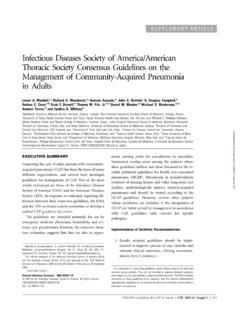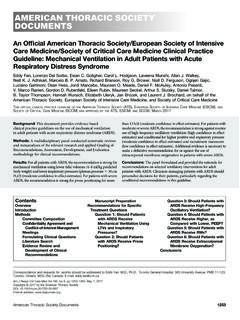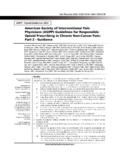Transcription of Society of American Gastrointestinal and …
1 SAGES Society of American Gastrointestinal and endoscopic surgeons Laparoscopy Preparation and Troubleshooting Guide Developed and Distributed by the SAGES Continuing Education Committee To minimize equipment malfunction, scheduled routine maintenance should be in place for all components of laparoscopy. Manufacturers' recommendations for routine replacement of some parts ( bulbs) should be taken into consideration. PREOPERATIVE PRECAUTIONS. Circulator Nurse Duties or Tasks Prior to patient entry into operating room. After patient enters operating room 1. OR table position: Assure OR table is properly set up for the 1. Verify of patient and the procedure to be procedure. For laparoscopic cholecystectomy, table should be done with patient and operating room team, including verifying positioned so cholangiography can be done. For laparoscopic site of surgery. foregut procedures, have spreader bars or other leg supports 2. Assist in proper positioning of patient on operating room table attached.
2 Ensure that tilt mechanism is functional and table & and ensure that pressure points are well padded. joints are level. Have bean-bag mattress with padding on table for 3. Secure patient to operating room table, apply safety strap. advanced procedures. Have lead shielding available if is to be done. Set up foot board when indicated. 4. Post anesthesia induction, apply electrocautery grounding pad to patient and connect to electrocautery unit. 2. Power sources: Check that all power sources are connected and 5. Post prep and drape, connect all lines passed from sterile eld to device units are switched on (Don't use multi-socket single appropriate units camera cord, light source, cautery cord(s), suction/. source or circuit will overload). irrigation lines and CO2 tubing. Ensure that CO2 tubing is securely 3. CO2 Assure adequate volume of CO2 gas (green zone attached to ins ator line. Verify that suction line is turned on and on LED) and availability of backup up CO2 tank.
3 (Have connected and irrigation line is open if irrigation is to be used. wrench and gasket available). Check that alarm is set to 6. Position any foot pedals (electrocautery, ultrasonic coagulator, function properly. etc.) appropriate to surgeon position and preference. 4. Electrosurgical unit: Check proper functioning of auditory alarm 7. Place SCD's to both legs according to surgeon preference. and have patient grounding pad available. 8. Complete checklist of Patient's Preparation for Surgery. 5. Video monitors: Ensure that video monitors are operational and position monitors in a location appropriate for the procedure. Scrub Tech/ RN Duties Check that a test pattern appears on the monitor before the 1. Check functionality of reusable instruments; check free movement camera is plugged in. of instrument handles and jaws; check sealing caps for cracked rubber, stretched openings; check to assure that instrument 6. Suction/irrigation: Check that suction canister is set up and cleaning channel screw caps are in place.
4 Irrigation bag is available and attached to pressure irrigation 2. Check Veress needle for proper plunger/spring action and assure unit if needed for procedure. easy through stopcock and/or needle channel. 7. Have sequential compression devices (SCD's), Foley catheter and 3. If Hasson cannula to be used, assure availability of stay sutures and nasogastric tube available. retractors. Check valves, plunger, spring, and assure tight seals on 8. Assure that video documentation sources are operational and CD, reusable Hasson cannula. Assure availability of appropriate size DVD or VHS tape is available. and type of accessory trocars. 9. Minimize clutter; move cables and tubing so that they will 4. Close stopcocks on all ports. not interfere with stretcher, C-arm, surgeons , etc. 5. Check laparoscope for clarity and vision. 6. Have local anesthetic of choice and injection syringe available. 7. When cholangiography is anticipated prior to surgery or cystic duct is cannulated during procedure, mix and appropriately dilute cholangiogram contrast solution.
5 Evacuate cholangiography tubing, syringe, and catheter of all air bubbles. Troubleshooting P R OB L E M C AU S E S O LU T I O N. 1. Poor of pneumoperitoneum CO2 tank empty or volume low Change tank Accessory port stopcock(s) open Inspect all accessory ports. Open or close stopcock(s) as needed Leak in sealing cap, reducer Change cap or stopcock cannula Excessive suctioning pressure Allow time to reinsufflate, lower suction Loose, disconnected or kinked tubing Tighten connections or reconnect at source or at port, unkink tubing Hasson stay sutures loose Replace or secure sutures CO2 flow rate set too low Adjust flow rate Valve on CO2 tank not fully open Use valve wrench to open fully Leak at skin where port enters cavity Apply penetrating towel clip or suture around port 2. Excessive pressure required for (initial or subsequent). Veress needle or cannula tip not in peritoneal space Reposition needle or cannula under visualization if possible Occlusion of tubing (kinking, table joints, etc.)
6 Inspect full length of tubing CO2 port stopcock turned off Fully open stopcock Patient is light Communicate to anesthesia Morbidly obese patient Use longer Veress needle 3. Inadequate lighting (partial/complete loss). Light is dim Increase gain. Check scope for adequate fiberoptics. Replace light cable, laparoscope and/or camera Light is on standby Take light off standby Loose connection at source or scope Adjust connection Light is on manual-minimum Go to automatic . Fiber optics are damaged Replace light cable Automatic iris adjusting to bright from instrument Re-position instruments, or switch to manual . Monitor brightness turned down Readjust brightness setting, adjust gain Room brightness floods monitors Dim room lights Bulb is burned out Replace bulb Scope dark Check white balance 4. Poor quality picture Flickering electrical interference, poor cable shielding Replace cautery cables, switch camera head, make sure cables don't cross, use plug points Color problems White balance camera, check chrome on monitor, check printer/VCR/digital capture cables Glare not caused by lighting Check for loose cables not plugged in 5.
7 Lighting too bright Light is on manual-maximum Boost on light source is activated Monitor brightness turned up Go to automatic, Deactivate boost , Readjust setting 6. No picture on monitor(s). Camera control or other components (VCR, printer, Make sure all power sources are plugged in and turned on light source, monitor) not on . Cable connector between camera control unit and/or Cable should run from video out on camera control unit to monitors not attached properly video in on primary monitor. Use compatible cables for camera unit and light source Cable between monitors not connected Cable should run from video out on primary monitor to video in on secondary monitor Input select button on monitor doesn't match video in choice Assure matching selection Input selection button on monitor or video peripherals (eg VCR, digital capture, printer) not selected Adjust input selection 7. Poor quality picture a. fogging/haze Condensation on lens from cold scope entering warm abdomen Use anti-fog solution or hot water, wipe lens externally Condensation on scope eyepiece, camera lens Detach camera from scope (or camera from coupler).
8 Inspect and clean lens as needed b. electrical interference Moisture in camera cable connecting plug Use suction or compressed air to dry out moisture (don't use cotton tip applicators on multi-pronged plug). Poor cable shielding Move electrosurgical unit to different circuit or away from video equipment, make sure cables do not cross, switch camera head; replace cables as necessary Insecure connection of video cable between monitors Reattach video cable at each monitor c. blurring, distortion Incorrect focus Adjust camera focus ring Cracked lens, internal moisture Inspect scope/camera, replace if needed Too grainy Adjust enhancement and/or grain setting for units with this option 8. Inadequate suction/irrigation Occlusion of tubing (kinking, blood clot, etc.) Inspect full length of tubing. If necessary, detach from instrument and tubing with sterile saline Occlusion of valves in suction/irrigator device Detach tubing, device with sterile saline Not attached to wall suction Inspect and secure suction & wall source connector Irrigation container not pressurized Inspect pressure bag or compressed gas source, connector, pressure dial setting 9.
9 Absent or weak cauterization Patient not grounded properly Assure adequate grounding pad contact Connection between electro-surgical unit and instrument loose Inspect both connecting points Foot pedal or hand switch not connected to electro-surgical unit Make connection Wrong output selected Correct output choice Connected to the wrong socket on the electro-surgical unit Check that cable is attached to endoscopic socket Instrument insulation failure outside of surgeon's view Use new instrument and inspect insulation Society of American Gastrointestinal and endoscopic surgeons 11300 W. Olympic Blvd, Suite 600, Los Angeles, CA 90064. Phone: (310) 437-0544 t Fax: (310) 437-0585 t E-mail: t






